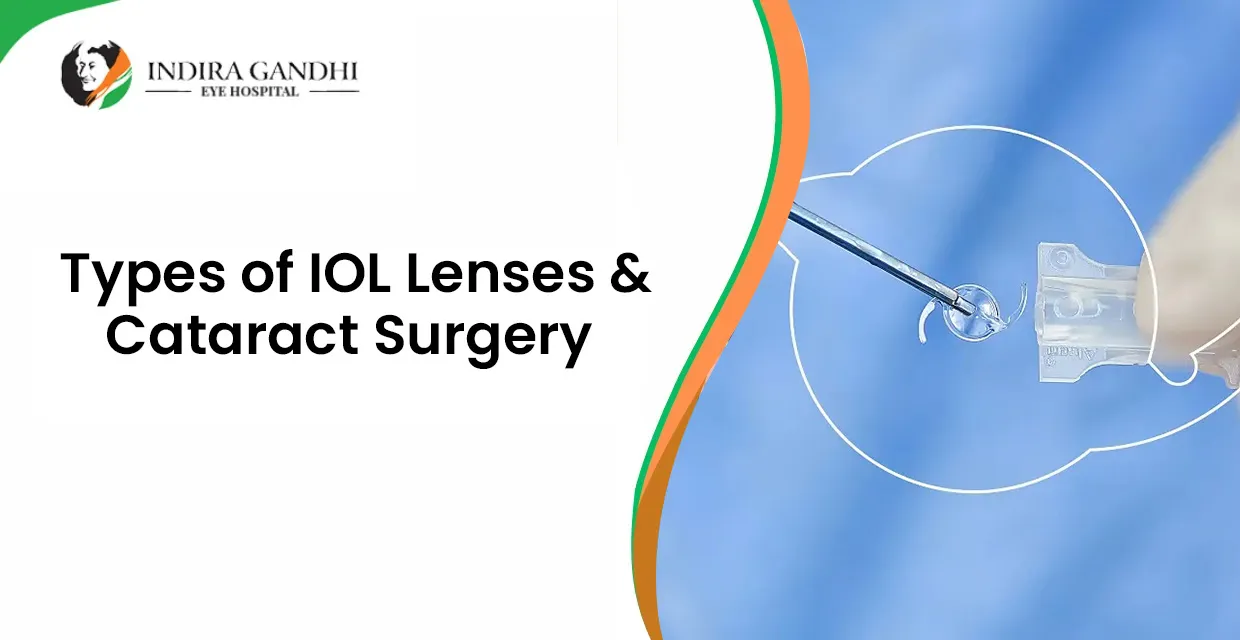Introduction
Greetings! If you've been contemplating cataract surgery, you're in the right place. We're delving into the intriguing realm of intraocular lenses (IOLs) to help you pinpoint the ideal visual aid post-surgery.
Cataract surgery stands out as one of the most common and successful procedures globally. In this procedure, the eye's cloudy lens is replaced with an artificial lens or IOL. With various types available, ranging from traditional monofocal lenses to advanced multifocal options, this comprehensive blog explores the intricacies of each IOL type. Join us on this journey of knowledge!
Understanding IOLs
IOLs are compact yet potent optical devices with the ability to enhance vision and quality of life. Let's grasp how all IOL lens types work and the unique benefits they bring to ophthalmology.
Types of IOL Lens
Here are the primary types of IOL lenses:
Monofocal
Monofocal IOLs, traditional and widely used, offer a single focal point for clear vision at a specific distance – near, intermediate, or far. Patients opting for monofocal IOLs often rely on reading glasses for close-up tasks.
Advantages
Predictable Results: Ideal for patients with straightforward vision needs.
Cost-effective: More budget-friendly compared to multifocal lenses.
Low Risk of Visual Disturbances: Lower risk of issues like halos and glare, beneficial for night driving.
Multifocal
Multifocal lenses provide multiple focal points within a single lens, eliminating the need for glasses. Effective in correcting presbyopia, these lenses offer clear vision at different distances.
Advantages:
Reduced Dependence on Glasses: Clear vision at various distances without glasses.
Enhanced Quality of Life: Versatility for a wide range of activities.
Extended Depth-of-Focus Lens
The latest innovation, extended depth-of-focus IOLs, provides continuous vision across varying distances without distinct focal points. Unlike multifocal IOLs, it aims to reduce visual disturbances.
Advantages
Continuous Range of Vision: Seamless vision across distances.
Improved Intermediate Vision: Clear vision for tasks like computer use.
Enhanced Night Vision: Better night vision compared to some multifocal options.
Light-adjustable Lens
The light-adjustable lens allows post-cataract surgery customisation, optimising the patient's vision as needed.
Advantages
Personalised Vision: Adjustable to meet unique visual requirements.
Reduced Need for Multiple Surgeries: Modification after initial surgery eliminates the need for additional procedures.
High Precision: Precise correction for potentially excellent outcomes.
Toric Intraocular Lens
Toric IOLs are designed to correct astigmatism, with a toric shape catering to the irregular curvature of the cornea.
Advantages
Astigmatism Correction: Improves overall vision quality.
Reduced Need for Glasses: Less dependence on glasses for distance vision.
Improved Contrast Sensitivity: Sharper vision, especially in low-light conditions.
Accommodating IOL Lens
Accommodating IOLs enhance the natural flexibility of the eye’s lens, adjusting to the eye’s focusing muscles for clear vision at varying distances.
Advantages
Near-natural Vision: Provides a more natural visual experience.
Reduced Dependence on Glasses: Improved near and intermediate vision.
Less Risk of Visual Disturbances: Lower risk compared to multifocal IOLs.
Custom and Enhanced Intraocular Lens
Custom and enhanced IOLs cater to specific vision needs, offering tailored solutions for a range of refractive errors and combining with other advanced technologies.
Advantages
Individualised Solutions: Customisable for various visual imperfections.
Comprehensive Correction: Addresses cataracts and refractive errors.
Enhanced Visual Outcomes: Excellent and often superior results.
A Comparative Table of All Intraocular Lens Types
Characteristic | Monofocal IOL | Multifocal IOL | Toric IOL | Accommodating IOL |
Vision Correction | Single focal point (usually distance) | Multiple focal points (distance and near) | Single focal point for astigmatism | Single focal point (usually distance vision) |
Near Vision | Requires reading glasses | Reduced dependency on reading glasses | Requires reading glasses | Reduced dependency on reading glasses |
Distance Vision | Clear, but may require glasses for near | Clear for distance, but may experience halos or glare | Clear, but may require glasses for near | Clear, but may require glasses for near |
Astigmatism Correction | No | No | Yes | No |
Quality of Vision | Excellent for distance vision | Good for both near and distance vision | Excellent for distance vision and astigmatism | Good for both distance vision, but may have some halos or glare |
Adjustability | Not adjustable | Not adjustable | Not adjustable | Limited adjustability |
Typical Candidacy | Patients who prioritise distance vision | Patients who desire reduced dependence on glasses | Patients with astigmatism | Patients seeking less dependence on glasses |
Surgical Complexity | Straightforward procedure | Straightforward procedure | Straightforward procedure | Straightforward procedure |
Cost | Typically lower | Typically higher | Typically higher | Typically higher |
Factors to Consider in Choosing an IOL for Cataract Surgery
Selecting the right IOL for cataract surgery involves careful consideration of several factors, including:
Visual Needs: Consider your lifestyle and daily activities to choose an IOL that aligns with your preferences.
Existing Refractive Errors: Certain IOLs are better suited to correct specific refractive issues.
Lifestyle and Hobbies: Discuss your interests with your surgeon to determine the best-suited IOL.
Budget: Be mindful of the cost variation associated with different IOL types.
Tolerance for Visual Disturbances: Assess your tolerance for potential visual disturbances, especially with premium IOLs.
Health and Medical Considerations: Factor in any pre-existing conditions or medications that could affect the surgery outcome.
Conclusion
Cataract surgery, coupled with the appropriate intraocular lens, plays a pivotal role in significantly improving vision and enhancing the overall quality of life. The diverse range of available intraocular lens types empowers individuals to make choices that align precisely with their unique visual requirements and lifestyle preferences. The ultimate objective is to restore clear and comfortable vision across all activities, spanning from reading to distant vision.
At the Indira Gandhi Eye Hospital & Research Centre, acknowledged as one of the best eye hospitals in India, we have a strong reputation for successful cataract surgery. Our commitment to excellence extends to providing a comprehensive array of eye care services, including cutting-edge procedures such as Contoura Vision, ICL surgery, refractive surgery, and more. Visit us for a transformative and crystal-clear vision experience.


